Birkenau Women's Camp

Women's camp at Birkenau
The photo above was taken from the tower
on top of the gate house at the Auschwitz II camp, known as Birkenau.
The Birkenau camp was originally built in 1941 to house Soviet
Prisoners of War. The homes of Polish residents in the village
of Birkenau were confiscated and the POWs had to tear down the
houses with their bare hands and use the bricks to build barracks
buildings.
The photo below shows the main camp road
which goes past the women's camp; the wooden guard tower was
added after the Birkenau camp became a Memorial site. Notice
the poles for electrical lines which were there when the camp
was used to house prisoners.
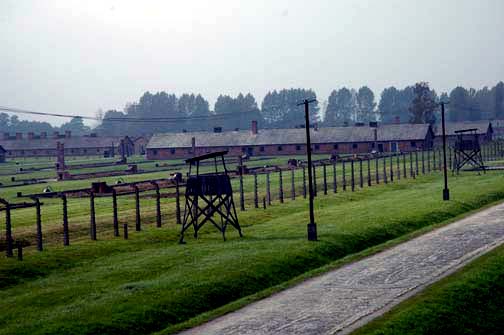 Early morning photo
of the former women's camp
Early morning photo
of the former women's camp
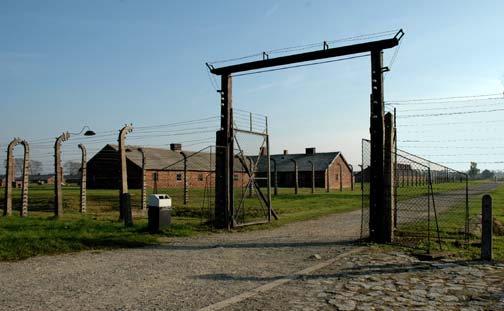
Interior gate into
women's camp
From a distance, the women's barracks
look like nice brick buildings, but wait until you see the interior!
The Birkenau camp was built on a marsh and the ground is always
wet. It didn't rain the whole time I was there, but the women's
barracks were damp inside and they smelled like a basement that
leaks.
The photo below shows a close-up of the
ground near one of the brick barracks. Notice that the building
is built directly on the wet ground with no foundation. The ground
has moss growing on it, which indicates that this area was constantly
wet. Survivors said that the ground between the barracks in the
women's camp was always muddy. Even today, the ground near the
barracks is uneven because the mud was churned by millions of
feet walking on it.
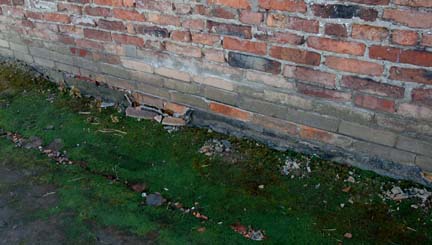 Brick barracks were
built with no foundation
Brick barracks were
built with no foundation
The photo below shows the bunks inside
one of the brick buildings in the women's camp. The prisoners
slept in three tiers with the bottom tier on the brick floor.
The bunks were almost as wide as a double bed, but 5 or more
women had to sleep in one bunk. The bunks were very short and
any woman over 5 ft. 6 in. tall would not have been able to stretch
out. There were no mattresses; the prisoners slept on straw that
was damp and worse than nothing at all. It is a miracle that
anyone survived in this atmosphere which was conducive to illness.
 Three-tier bunks in
women's camp
Three-tier bunks in
women's camp
The brick barracks buildings did not
have a stove running down the center, as in the wooden barracks.
Instead, there were bunks down the center of the building with
two rows of beds, back to back. There were two more rows of bunks,
one against each outside wall. A brick stove was at the end of
each building.
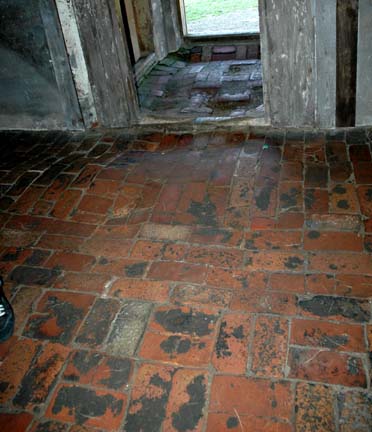 Brick floor in women's
barracks is not level
Brick floor in women's
barracks is not level
The photo above shows the brick floor
in one of the women's barracks. The brick buildings had no foundations
and the bricks were just laid on the bare ground. The floor became
very uneven as the women walked on it and the muddy ground underneath
caused the floor to buckle. At the top of the photo above, you
can see the entrance door and a stone floor that is very uneven.
On the top left in the photo, you can see the doorway into the
tiny room where the block leader had a bed all to herself.
Another barrack building that I entered
had a concrete floor, but it was so broken and buckled that it
was dangerous to walk on.
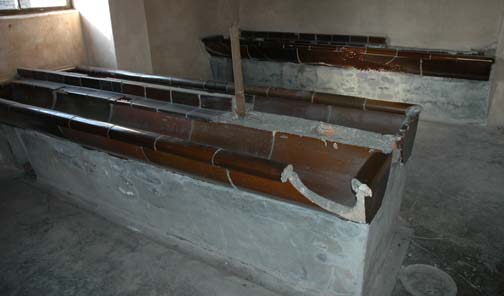 Two long wash basins
in one of the women's barracks.
Two long wash basins
in one of the women's barracks.
The photo above shows a washroom in one
of the women's barracks. There are two long basins where the
women had to wash with cold water. The men's camp had washrooms
in a separate building. The toilets were in another building
in both the men's and women's camps.
The women had no soap or towels, no shampoo,
no mirrors, no nail files, no toenail clippers, not even a handkerchief
to blow their noses. The women who were the most likely to survive
were the ones who worked in the clothing warehouses where they
could steal items from the luggage of the incoming prisoners,
or the women who worked in the kitchen who could steal extra
food to trade for clothes or other necessities.
The photo below shows a wooden building
in the women's camp with the gate house at the camp entrance
in the background on the right. An old photo, taken when the
camp was in operation, showed women lined up in front of this
building for roll call.
 Medical building in
Women's camp
Medical building in
Women's camp
According to a sign at this location,
"SS doctors and nurses murdered mothers and their newborns
with phenol injections" in this building.
 Kitchen building in
Women's Camp
Kitchen building in
Women's Camp
This page was last updated on March 24,
2009
|